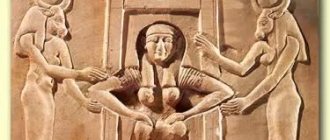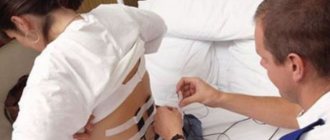Proper breathing during childbirth makes labor easier and improves the well-being of mother and child. When preparing for childbirth, much attention is paid to breathing, exercises and various methods of behavior during contractions. Why is it so important to breathe correctly during labor and what is the breathing technique during childbirth?
Experiencing increasing pain during contractions, the expectant mother becomes nervous, her pulse quickens, her breathing becomes labored, the woman no longer controls the situation and cannot alleviate her condition - this intensifies the pain, and the dilatation of the cervix is inhibited. But if you normalize breathing during labor and childbirth, the situation will change. The easiest way to see what breathing should and should not be like during childbirth is through video. There are now many educational lessons posted on the Internet to prepare for childbirth. Breathing in the video is shown both for the period of contractions and for the period of pushing.
Proper breathing during childbirth ensures:
- acceleration of labor. A woman who breathes correctly does not focus on pain, but controls the alternation of inhalations and exhalations, due to which the cervix opens faster;
- muscle relaxation. Measured breathing helps relax muscles, which means it facilitates labor;
- reduction of pain. If the muscles are “compressed into a ball,” the pain intensifies with each contraction of the uterus. With relaxed muscles, pain decreases;
- saturating the body with oxygen. Proper breathing allows you to actively supply oxygen to all the muscles that experience increased stress during childbirth, as well as to the baby itself.
Webinar “Childbirth without pain: breathing + relaxation”
Part 1. How does the body prepare for childbirth? Part 1.1_Cardiovascular system Part 1.2_Respiratory system Part 1.3_Emotional sphere Part 1.4_Q&A Questions: /Swelling in the second trimester/ /Drowsiness in the last weeks of pregnancy/ /Physical activity in pregnancy/ /Insomnia at the end of pregnancy/
Part 2. What does a baby feel during childbirth? Part 2.1_State of hibernation Part 2.2_Q&A Questions: /Childbirth in dim light/ /Caesarean section/ /Stimulation during labor/ /Stimulation of the newborn's breathing with a slap/ /Poses for childbirth/ /The influence of the baby's presentation on his condition during labor/
Part 3. Stages of labor Part 3.1_Start of labor Part 3.2_First period (dilation) Part 3.3_Second period (pushing) Part 3.4_Third period (successive) Part 3.5_Q&A Questions: /Training contractions/ /Why you can’t push until you are fully dilated/ / Post-term pregnancy/ /Rule 10/ /How to determine the opening yourself/ /The expression “blow on the navel”/
Part 4. Why does pain occur during childbirth? Part 4.1_Causes of pain during childbirth Part 4.2_Q&A Questions: /Is it possible to push until full dilation/ /The likelihood of repeat episiotomy in the next birth/ /The likelihood of ruptures during vertical birth/ /What determines the duration of labor/
Part 5. Mother’s tasks during childbirth Part 5.1_Mom’s tasks during childbirth
Part 6. Why is it important to breathe properly? Part 6.1_Importance of breathing exercises
Part 7. Relaxation and rest during childbirth Part 7.1_Mask of relaxation Part 7.2_Q&A Questions: /Clarifications on relaxation techniques/ /State at the time of the onset of contractions/ /Understanding the process reduces fear/ /Pose at the moment of relaxation/ /Why you shouldn’t lie on back/ /What to do during a contraction/
Part 8. Breathing exercises Part 8.1_Abdominal breathing Part 8.2_Full breathing Part 8.3_Economy breathing Part 8.4_Controlled breathing (type A) Part 8.5_Controlled breathing (type B) Part 8.6_Pause training Part 8.7_Breathing at the beginning of labor Part 8.8_Doggy style breathing "Part 8.9_"Breathing of an eagle owl" Part 8.10_Pushing breathing Part 8.11_"Game of childbirth" Part 8.12_About the technique
<<Workout scheme>>
Thank you for attention!
If this webinar was interesting and useful for you, please leave your feedback in the comments HERE. Thank you!
Additional materials for the webinar “Childbirth without pain”:
Useful materials: 1. Article “Key needs of a woman during childbirth.” 2. Article “69 facts about childbirth that are worth knowing.” 3. Article “The Rule of Ten,” or the Myth about cervical edema.” 4. Article “So much blood!!!” 5. Video “Physiological birth and the first hour after birth.” 6. Article “Umbilical cord clamping: a monument to gynecological stupidity.” 7. A film about childbirth. 8. Article “Epidural anesthesia – two sides of the coin.” 9. Article “On the rights of women and children in medical institutions.” 10. METHODOLOGICAL LETTER OF THE MINISTRY OF HEALTH AND SOCIAL DEVELOPMENT OF THE RUSSIA No. 15-4/10/2-6796 DATED JULY 13, 2011 11. FEDERAL LAW ON THE BASICS OF CITIZENS’ HEALTH PROTECTION IN THE RUSSIAN FEDERATION N 323-ФЗ dated 11/21/201 1 year (as amended on June 25. 2012). 12. Training scheme for breathing exercises
Recommended books: 1. Grently Dick-Reed “Childbirth without fear” 2. Auden Michel “Revived Childbirth” 3. Auden Michel “Caesarean section: Safe exit or threat to the future?”
Homework:
1. Be sure to watch the film about childbirth from the “Additional Materials” section, which clearly shows the physiological aspects. If there are any points you do not fully understand or cause you anxiety, ask your doctor or reproductive psychologist questions.
2. Carefully study the video materials and breathing exercises diagram. Start practicing breathing exercises as early as possible, ideally from the 7th week of pregnancy. The more time you devote to training, the better you will prepare your body and bring your breathing techniques to automaticity, so that you no longer think about your actions during childbirth.
Breathing technique during childbirth
Breathing is an unconditioned reflex, and in the normal state, each of us breathes without thinking about it. But during childbirth, due to severe pain and muscle tension, a woman often “forgets” to inhale deeply and exhale slowly.
The technique of proper breathing during childbirth is to control inhalation and exhalation. At different stages of childbirth, a woman should breathe differently, but always by controlling the number and duration of inhalations and exhalations.
Breathing techniques during childbirth are based on the fact that the diaphragm helps breathing, and does not complicate the process. There are different breathing techniques during childbirth, videos and descriptions of these techniques will allow a pregnant woman to prepare for the process of childbirth, practice proper breathing skills in advance and bring them to automatism. After all, if a woman goes into labor, breathing and behavior, the video of which she watched, she will need to automatically repeat.
Examples of some breathing exercises
Breathing techniques during childbirth can be different, and various techniques can be combined. In this article we will look at four main types of breathing movements that will provide invaluable assistance to a woman at the most crucial moment.
The first exercise to train breathing during childbirth
In this case, breathing during childbirth is aimed at practicing a relaxing type of breathing movements. It consists in taking a deep breath through the nose and exhaling smoothly through the mouth, with the lips drawn out into a tube. There should be a short pause between inhalation and exhalation. To evaluate whether you are doing everything correctly, you need to take a mirror. It should be held at chin level. Exhalation should lead to gradual fogging of the mirror. If you manage to take 10 correct inhalations and exhalations in a row, then you no longer need to use a mirror for control. However, the main test of the correctness of this exercise will be childbirth.
Breathing and behavior at this time should be calm; you should not shake your head and neck, as this disrupts the process of oxygen supply. This type of breathing will be especially useful at the very beginning of labor, as well as in the intervals between contractions.
The second exercise for training breathing during childbirth
It is also necessary to practice such breathing during labor and childbirth, which will be superficial. It will be useful in the following cases:
- to relieve pain when contractions intensify during the active phase of labor;
- in order to breathe through the pushing when it is impossible to push (we are talking about cutting through the parietal tubercles, that is, the largest circumference of the head, when it needs to be brought out outside the pushing). As a result, this will avoid perineal ruptures.
To practice this breathing skills, you need to inhale and exhale either only through the nose or only through the mouth. All breathing movements should be light and fast. Only those movements that are carried out by the chest without the participation of the anterior abdominal wall, which must remain motionless, should be considered correct. The duration of both inhalation and exhalation should be approximately the same. At the beginning of training, this exercise should not be performed for more than 10 seconds, and then you can gradually increase it to a minute.
The third exercise for training breathing during childbirth
Breathing during childbirth may also be intermittent. It can bring the greatest value in the second stage of labor (the period of expulsion of the fetus), when it is necessary to breathe through contractions or attempts.
It consists in the fact that it is performed at a constant and fast pace, and also with the participation of only the chest. To breathe intermittently, you need to open your mouth and touch the tip of your tongue to the lower incisors, while inhaling and exhaling should be noisy (somewhat reminiscent of dogs breathing after running).
The fourth exercise for breathing during childbirth
Sometimes deep breathing is required during childbirth with a delay in exhalation. It is usually used in the second stage of labor when the fetal head is cutting in/erupting.
This exercise will help ensure that the emerging head will not hide again. To breathe like this, you need to take a deep breath through your nose. Without exhaling, you need to count to 10 (gradually increase to 20-25), and then exhale smoothly, but through your mouth. As you exhale, you can make hissing sounds.
Thus, with the help of these breathing techniques you can help both yourself and your baby. Breathing during childbirth, a video of it will allow you to better master the correct technique. However, it will be effective only if the training is performed regularly and not from the end of pregnancy.
Breathing during childbirth: contractions
If contractions are already regular and the pain intensifies, the most important thing is not to strain or scream, this interferes with the dilation of the cervix. When labor occurs, the breathing and behavior of the mother in labor help the baby move through the birth canal and allow the birth process to proceed as quickly as possible and without outside stimulation. No matter how much you want to curl up on the bed and moan, you need to get up and try to move and breathe correctly - you’ll see, it will become much easier to endure contractions this way.
When preparing for childbirth, breathing should be measured. While the contractions are not yet so strong, you need to slowly inhale air (counting to four) and exhale even more slowly (counting to six). Breathing, in which the inhalation is longer than the exhalation, allows you to calm down and relax.
When contractions become intense, it is no longer possible to breathe so steadily. In this case, it is necessary to use dog breathing. During childbirth, this technique allows you to endure the most severe contractions without unnecessary stress. Canine panting is rapid, shallow breathing with an open mouth. You need to start breathing like a dog when the contraction just begins. The more intense the contraction, the more often you need to breathe. At the end of the contraction, when the pain subsides, you need to take a deep breath and exhale smoothly. To learn how to breathe during childbirth, video lessons and breathing techniques must be studied in advance and repeatedly practiced in their use at home.
Basic recommendations for proper breathing during childbirth
In order to breathe effectively during childbirth, this must be learned in advance. Therefore, it is necessary to start during pregnancy. This is a kind of preparation for childbirth. Breathing plays one of the leading roles in this process.
You should adhere to certain rules of breathing during childbirth, which are as follows:
- training must begin from the end of the first trimester - the beginning of the second;
- It is recommended to continue them until the very end of pregnancy;
- If dizziness, weakness, flashing of spots or other unpleasant symptoms appear, then you need to start breathing as usual. These symptoms are regarded as manifestations of hyperoxemia, which is comparable to the sensations that a person experiences when climbing mountains;
- at the end of each exercise it is necessary to restore breathing;
- training should take place in a comfortable position;
- Before you begin special breathing, the room must be thoroughly ventilated. Ideally, perform all exercises outdoors in an ecologically clean area.
Thus, proper breathing during childbirth requires long-term and targeted training. Conscious women do not waste time, but devote a lot of time and attention to this issue.
Breathing during childbirth: pushing
The breathing and behavior of a woman in labor during pushing is usually controlled by a midwife: she tells you when and how to push, and when you need to “breathe” through the pushing. If we talk about general principles, breathing during pushing looks like this: take a deep breath through your nose and exhale through your mouth, sharply, aimed at the uterus and pushing out the baby, and not at the head.
If you are going into labor, the correct breathing video you watched during pregnancy should appear before your eyes. When the contraction begins, relax as much as possible, take a deep breath and exhale slowly, and if necessary, do dog breathing. Practice proper breathing in advance - this will make the birth process much easier.
How to breathe during labor and childbirth
In the coming hours before giving birth, the pregnant woman begins to feel nagging pain in the lower abdomen. Basically, she already intuitively knows that the decisive moment will soon come. It is not surprising that the main emotions at this time are excitement and fear. This is where knowing how to breathe correctly during childbirth and labor comes in handy.
Breathing during uterine dilatation
During the latent period, a woman can benefit from relaxing breathing. It involves calm and deep inhalation through the nose, while exhaling through the mouth. Inhalation is usually shorter than exhalation. A woman can silently count to three while inhaling, and to five while exhaling.
Gradually the contractions become stronger. The main task of a woman in labor at this time is not to strain her stomach and legs. The relief will be short-lived, but it will take away the necessary strength. In the active stage, the same deep breathing helps to relax the abdominal muscles, ease pain and calm down mentally.
You will need to use rapid breathing when spasms lengthen in time and intensity. You should breathe without straining, often and not deeply, inhaling and exhaling through your mouth, which is slightly open. The stomach does not participate in breathing - only the chest; this technique reduces pain if the woman fully concentrates on the technique. It is “dog” breathing in the first stage of labor that makes it possible to avoid uterine ruptures.
At the end of the spasm, even breathing is used without using the abdomen. It should be slow, calm, and carried out through the nose or mouth. This allows the woman in labor to rest and gain new strength. Along with uniform breathing, deep breathing can also be successfully used at the end of the contraction.
Breathing while pushing
Pushing marks the birth of a little person, so this is a very important period of labor. Contractions of muscle tissue begin after the baby's head enters the vagina, they help move the fetus along the birth canal. To help him, you will need deep and slow breathing and prolonged exhalation, due to which the resulting pressure forces the mother's diaphragm to exert maximum pressure on the uterus.
At this time, a woman needs maximum calm and presence of mind to help the baby be born, and proper breathing makes attempts more fruitful. In addition, the woman in labor must remember other important rules: push specifically into the uterus and vagina, and do not throw back her head. At this stage, she needs to follow all the obstetrician’s commands, and then she can count on the speedy expulsion of the fetus. When the baby's head is shown, the woman in labor will need to use rapid breathing again so as not to injure the baby.
Departure of the "children's place"
But this is not the end of labor, although the release of the baby’s place is the least painless part of childbirth. About 30 minutes should pass after the baby appears. Contractions, but weaker, begin again. To expel the placenta, you will have to push using deep and calm breathing. Usually the doctor will indicate when this is necessary.
Why is breathing correctly so important?
Obstetricians and gynecologists are confident that correct breathing technique means an almost easy birth. Inhalation and exhalation of a certain depth and at certain moments can reduce pain and speed up the process of the baby passing through the birth canal.
In many ways, all this is ensured by calmness and relaxation, which are achieved when the woman in labor does not interfere with the movements of the diaphragm, but helps herself. Moreover, the technique of proper breathing makes a woman focus on it, thinking less about discomfort and pain. But that's not all.
Starting from the third trimester, following the enlargement of the uterus, a slight upward shift of the lungs occurs. This is necessary in order to provide the fetus with a place for full growth and development. The woman does not notice these changes, but at a certain moment she simply begins to breathe more shallowly. Of course, everything returns to normal when the baby is born.
Until then, deep inhalations and exhalations are possible only if the pregnant woman controls herself. It is interesting that at the moment of contraction, the woman in labor intuitively contracts, tenses, trying to endure the pain that arises. If the latter is extremely strong, a cry escapes her. The worst part is that all this causes the muscles to tighten and the cervix to tense. In some cases, it turns to stone, meanwhile, the body continues to produce hormones to stretch it to its maximum.
But stretching a tense organ leads to the appearance of micro-tears on it. Needless to say, they again make the woman scream in pain, and so on in a circle. By the way, these gaps increase as the child passes through the birth canal. The technique of proper breathing during childbirth helps to break this circle.
Helping the woman in labor is not the only reason why breathing techniques should be mastered. Oxygen deficiency at the most crucial moment leads to the development of fetal hypoxia. What does this mean for the future? The child can:
- grow and develop slower than their peers;
- poor weight gain;
- have difficulty going through the period of adaptation to the environment;
- constantly get sick due to weakened immunity.
It is worth noting that breathing intensity is not the only thing that needs to be taken into account. These techniques have their own nuances that should be remembered at each stage of delivery. Due to the fact that at the moment of its onset a feeling of fear and anxiety appears, you should master the skills of proper breathing in advance. The optimal period, according to experts, is from the second trimester of pregnancy.
Breathing technique during contractions
Breathing during childbirth can be different, and this depends, first of all, on the period and intensity of contractions. The main thing is to follow the rule: the stronger and longer the contractions, the more frequent the breathing should be.
remember Breathing exercises in the first stage of labor play a big role, because many patients clamp down and try to suppress the contraction. However, this will not bring relief, but will only worsen the situation, because in this way the contractions do not stop, and the dilation of the cervix slows down greatly, as a result of which doctors are forced to resort to drug stimulation of labor. In addition, if breathing is improper, the child begins to suffer, experiencing oxygen deficiency (hypoxia).
At the beginning of labor, when the contractions are still slightly painful and have not gained strength, you should use slow deep breathing:
- The inhalation should be shorter than the exhalation;
- Inhalation is done through the nose;
- Exhale through the mouth, folding the lips into a “tube”;
- Use counting when breathing: for example, inhale by counting to 3, exhale by counting to 4-5.
This breathing technique will help the expectant mother relax as much as possible, calm down and saturate the body with oxygen.
For more intense contractions, you should switch to frequent shallow breathing: you can use the “candle” technique:
- Inhale through the nose, exhale through the mouth through elongated lips;
- You need to breathe very quickly and shallowly, as if you were blowing out a candle;
- At the end of the contraction, you can switch to slow breathing, described above.
After such breathing, slight dizziness may appear, which is associated with hyperventilation of the lungs. In addition, endorphins (“happiness hormones”) are released, which leads to a decrease in pain.
If during childbirth the “candle” technique does not have the desired effect, you can switch to “big candle” breathing:
- You should breathe with effort;
- Inhalation is performed as if through a stuffy nose;
- Exhale through almost closed lips
.
As a rule, this technique is used at the end of the first stage of labor, when contractions become very frequent and painful.
Separately, we should examine a situation that quite often occurs at the end of contractions, when the baby’s head begins to descend into the pelvic cavity, but the cervix is not yet fully dilated. At this moment, the woman in labor begins to experience very strong pressure and the desire to push, which is strictly prohibited, because can lead to severe cervical ruptures . A special technique of breathing exercises at this moment will provide invaluable assistance:
- Change body position (lie down, squat);
- When the contraction begins, breathe frequently several times (“candle”), then take a short breath and then breathe frequently again. Alternate techniques until the end of the fight;
- You should breathe normally between contractions.
It is also possible to use “doggie” breathing: with this technique, breathing during childbirth should be done very often and superficially with the mouth open, and both inhalation and exhalation should pass through the mouth.










